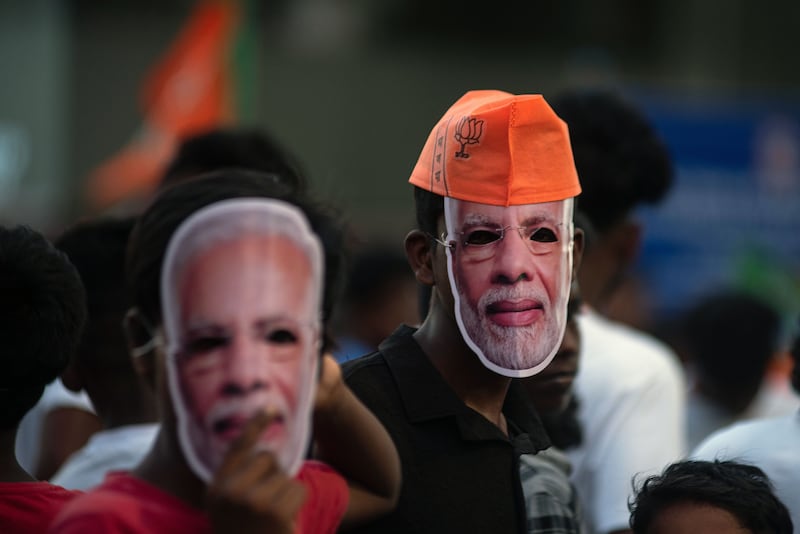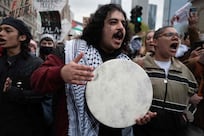“Whether they win, whether they lose, the BJP is going to be the centre of Indian polity – like it was for the Congress for the first 40 years [of India’s post-colonial history]. The BJP is going nowhere.”
So said Prashant Kishor, a renowned political strategist-turned-activist, two years ago as he tried to explain why the Bharatiya Janata Party’s thumping victories in the country’s 2014 and 2019 general elections were no flukes.
That Mr Kishor spoke in future tense, however, pointed to something more interesting: that the BJP was still in expansion mode, and that it was still on its way to becoming a genuine pan-India party like the Congress had been in its heyday.
As the six-week general election begins with the first phase of voting tomorrow, the question is not so much whether the BJP will once again emerge as the single-largest party in the Lok Sabha, as the lower house of Parliament is called. That seems to be the most likely outcome, according to several surveys carried out in recent months. Instead, the focus among pundits and the public has been on whether the party can break new ground to win large numbers of seats in India’s south, east and north-east. The jury is still out on this question.

The BJP’s recent electoral successes at all levels of government rest partly on the notion that Hindu nationalism, an ideology long championed by the right-wing party, has finally captured India’s political and cultural zeitgeist. Other factors include Prime Minister Narendra Modi’s popularity and his government’s efficient delivery of welfare schemes for the most marginalised sections of society.
However, what is often underappreciated is the fact that these wins are the result of the BJP’s years-long efforts to expand its voter base, particularly in the north and west.
Long pigeonholed as the party of the upper and middle castes, it has worked assiduously to bring millions of voters from myriad lower caste groups into its fold. The brute majorities in the 543-strong Lok Sabha – 282 seats in 2014 and 303 seats in 2019 – are simply a reflection of the truism that, in politics, there is strength in numbers.
Now Mr Modi wants to go even further. Earlier this year, he announced that his target for the BJP-led National Democratic Alliance was to win 400 seats (including 370 seats for his own party). The announcement was regarded as an attempt to boost the morale of fellow leaders, the cadre and ultimately the voter base – and to snuff out any whiff of complacency from within the party ranks. More importantly, it may have served to demoralise the Congress-led “India” coalition by creating a narrative, in the media and among voters, that victory for the NDA is inevitable.
Many theories swirl around the figure of 400, one of which is that Mr Modi seeks a two-thirds majority in the Lok Sabha that would help his government pass important constitutional amendments. This idea has scared some parties and their supporters who worry that the BJP will take away certain provisions protecting affirmative action, or that checks and balances will be removed to accumulate power in the executive. BJP leaders, including Mr Modi himself, have vociferously denied any such plans.
Whatever its compulsions, winning 400 seats – a mark that’s been breached just once before, by the Congress in 1984 – is an extremely tall order. But getting as close to this figure as possible is crucial for the BJP to realise its ambition of becoming a pan-national party. To achieve this, it would have to win over large swathes of voters outside the Hindi heartland, where there is little scope for it to improve its tally.
The problem for the BJP is that the southern and eastern regions are decidedly more liberal and have distinct ethnic, linguistic and societal differences that make it difficult for any party with strong ideological moorings to grow. The BJP, for instance, cannot win there by appealing to religious sentiments, by calling for a ban on the sale of beef or by insisting that the Hindi language be imposed in state school curriculums – all core issues close to the party faithful’s hearts.
This has forced the party to diversify its agenda, even at the risk of diluting its Hindutva ideology, particularly in the southern states and territories where Mr Modi has been campaigning strenuously to improve on the BJP’s 2019 tally of just 30 seats. His colleagues have in recent years even made outreach efforts to certain disaffected caste groups as well as Christian minorities, especially in the state of Kerala, where they know they cannot rely on simply courting the “Hindu” vote.
But as it turns out, when one part of the country sneezes, another part catches a cold. Months-long violence in the north-eastern state of Manipur, where the BJP is in power, has created ripples in faraway Kerala. The riots between the Meitei people, who are predominantly Hindu, and the Kuki-Zo tribal community, a majority of whom are Christian, have given pause to some of the largest and most powerful church groups in Kerala that had previously gravitated towards the BJP. Herein lies a palpable tension at the heart of India’s governing party.
On the one hand, it has been expanding its tent by bringing in parties with small but critical vote bases into the NDA. It has also been aggressively co-opting leaders from other parties and movements, as well as those representing farming lobbies, religious minorities and tribal groups. On the other hand, however, it has strived to remain committed to its ideological core and stay faithful to its vote base by appealing to their Hindu cultural identity. Mr Modi’s inauguration of a temple in the northern city of Ayodhya was key to this strategy.
No one can quibble with Mr Kishor’s assertion about the BJP’s pre-eminence in Indian politics. But how Mr Modi and his colleagues manage the many competing interests, narratives and newly acquired leaders from outside their core base will determine the success or failure of the party’s expansionary project across the large, diverse and complex country that is India.





